These 'smart' headphones personalize sound for your ears—but do they work?
The Nuraphones headphones claim to 'listen' to how you hear and tune music to match
 Credit:
Reviewed / Jackson Ruckar & Naidin Concul-Ticas
Credit:
Reviewed / Jackson Ruckar & Naidin Concul-Ticas
Products are chosen independently by our editors. Purchases made through our links may earn us a commission.
We at Reviewed are just as curious about those flashy products we see in our Instagram feeds as you are. For our 'As Seen On IG' series, our writers buy them and put them through their paces to find out if they're actually as good as they look online—or too good to be true. Spot one that we've missed? Email us at [email protected].
For people who really love music, finding the perfect pair of headphones is a lifelong journey. But what if you didn't even have to look? What if your headphones could adapt to you—specifically, to how your ears interpret sound—and play music that's perfectly tuned to them?
That's what the startup behind the Nuraphone Personalized Headphones—which advertises asiduously on Instagram—is promising. These high-tech over-ears feature embedded microphones that "listen" to your ear and tune playback accordingly. The result? A flawless aural atmosphere designed to complement your individual hearing. At least, that's the sales pitch.
The reality isn't quite as convincing, but some initial stumbling blocks aren't enough to dim our enthusiasm for what this technology could bring. Though the Nuraphones are a tough sell in a market that's saturated with fantastic noise-cancelling headphones from established brands, they’re a promising start.
What are Nuraphones?
If you spotted the Nuraphones in the wild, you'd never know there was anything that made them different from any other over-hear headphones. They’re stylish, sturdy, and feature large earcups that envelop your ears. But look closely and you'll see the first major difference: the large earcups house what are essentially two in-ear headphones. The in-ear portion goes deep in your ear like an earbud, while the cups outside seal around your ears.
What do the Nuraphones do well?

The Nuraphones are fun and well-designed, but are they worth the money?
Music sounds fantastic across multiple genres
If the Nuraphones have one superpower, it's their superb bass response. Getting good bass alongside clear mids and trebles through most of the range is pretty rare outside of the snazziest headphones, and it's something works equally well across a huge variety of genres (at least, with my personal Nuraphone sound profile).
Personally, I found that the Nuraphones excelled at rock and classical, though for classical it's essential to turn "Immersion" mode off (unless you want to know what EDM Boccherini sounds like). Hip-hop, rap, and pop were all solid as well, though I found they weren't quite as in tune with my tastes as similar headphones from Sennheiser, Sony, and Bose.
As with most high-end headphones, the Nuraphones really shine when you're listening to high-quality production. If there is supposed to be separation between elements, the Nuraphones will likely bring it out. This is especially true for me on tracks like "Harder than you think" from Public Enemy (the horn drop is absurd), or heavily remastered work like Queen's greatest hits.
Messier production like old analog/mono tracks can feel distractingly noisy, though more modern takes (like The White Stripes' debut album) are clean enough and the extra bass gives the music excellent presence.
They don't quite provide the airy feeling of open-back headphones... but they also don't have all the drawbacks of open-back headphones. You could easily use these on a plane with enough volume to drown out engine noise, which you can't do with open-backs unless you want your seatmates to hate you.
'Immersion mode' lets you feel closer to the performance
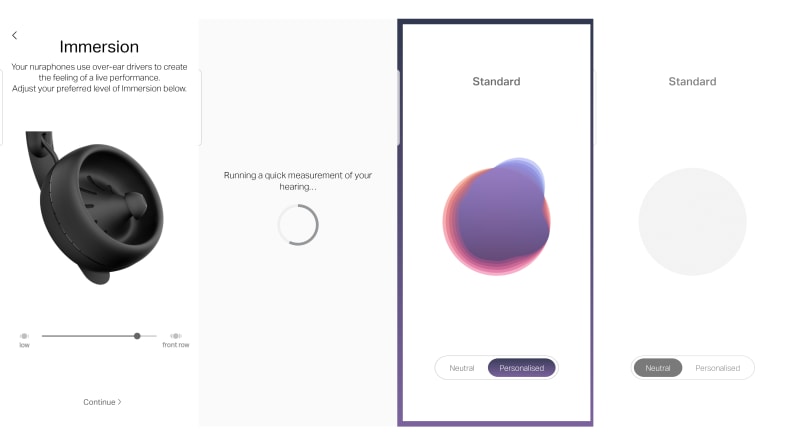
The Nura app walks you through the setup process and lets you tweak your sound profile.
One of the aspects I found surprisingly enjoyable about the Nuraphones was the ability to increase "immersion" through a simple slider in the companion app. The effect was immediately applied to whatever I was listening to and it made adjusting it frequently simple and easy.
The most obvious difference between "low" and "front row" immersion is the insane application of bass. That's good, because I found I had to adjust it all the time to get the best experience—sometimes from one song to another in the same genre. In front row mode, it feels like the headphones are literally shaking with bass and vocals are extremely crowded (to the point of being distorted). Basically, it feels like you're in the front row of a concert.
Personally, I don't love this mode for regular listening—it can be exhausting. But it is remarkable that a pair of headphones can replicate that feeling of being shaken by speakers so completely. It makes listening to something like AC/DC's "Thunderstruck" a real experience, with the hair on my arm shooting up as the first "Thun-der" drops and the bass bursts to life. {{spotify 'spotify:track:57bgtoPSgt236HzfBOd8kj'}}
The combined in-ear and over-ear design does an excellent job blocking noise
Noise-cancellation and isolation is something that is commonly misunderstood. Though most people think active noise cancellation is the best way to drown outside noise, the best way is to block out outside noise. In-ear headphones are usually excellent at this, though they typically lack active noise cancellation (as they don't need it).
The Nuraphones, which are effectively both in-ear headphones and over-ear headphones in one, have a huge advantage here. The in-ear portion blocks most noise quite well, while the active noise cancellation and over-ear cups should take care of the rest.
Unfortunately, we can't tell exactly how much noise the Nuraphones block, since they don't function on our head and torso simulator, an apparatus we use to test this feature on typical over-ear headphones. Anecdotally, they do about as good a job as most noise-cancelling headphones in my experience. They don't give you the floating feeling that you get from the Bose QuietComfort 35 Series II or the Sony WH-1000XM3 (the two best noise-cancelling headphones we've tested), but they're good.
One thing I really enjoy is the "social mode" which lets you quickly amplify the sound around you, like people talking. You can customize the controls so that a simple tap of one earcup engages this, letting you hear someone around you (and yourself) before quickly going back to your music.
Setup is a breeze—once you get them charged
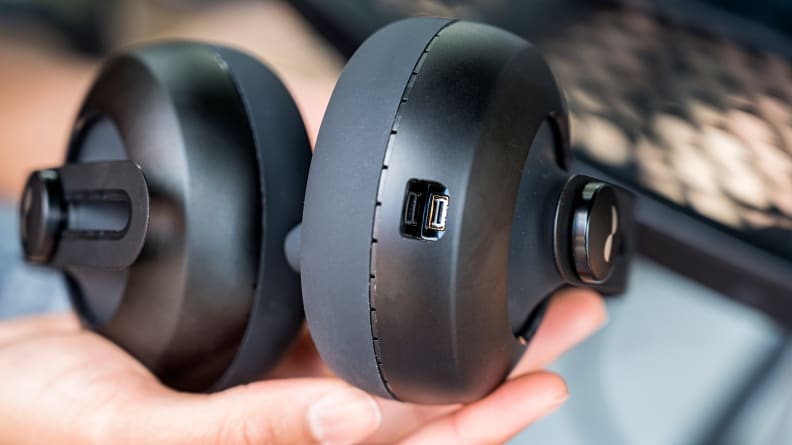
The Nuraphones charge via a port on the bottom of the earcup, with optional accessory cables for hooking up to standard audio ports.
While the premise of the Nuraphones sounds complex—a series of speakers and microphones playing tones to automatically diagnose your "ideal" sound profile—the actual process is dead simple.
We had a few hiccups getting the Nuraphones to charge. There isn't a charging light and I twice thought they were charging up only to find out they actually weren't. Yes, this is probably more a "me" problem than a Nuraphones problem. But once they're powered up, all you have to do is put the headphones on and download the app, which it takes it from there. The whole process is cool, involving the app playing a series of tones that sounds like something from an '80s video game.
Are the Nuraphones comfortable?

The Nuraphones are heavy, but they feature a nicely padded headband for comfort.
So what is it like wearing over-ear headphones that also have earbud-type-things that slip into your ears? It's like having a small child stick their fingers in your ears. Trust me, I'm a parent of two small children and I know precisely what that feels like. It's identical.
If a toddler giving you a wet willie sounds like it would mess up your ability to enjoy your music, then you are probably now realizing why headphones that look great, sound great, and have futuristic noise-cancelling capabilities haven't totally won us over.
That said, you really do get used to it, and it's not much different than every other pair of in-ear headphones. The Nuraphones are much heavier than in-ear headphones, of course, and the rigid structure of over-ears combined with the in-ear pressure gets pretty tiring after an hour or so.
Are the Nuraphones easy to use?
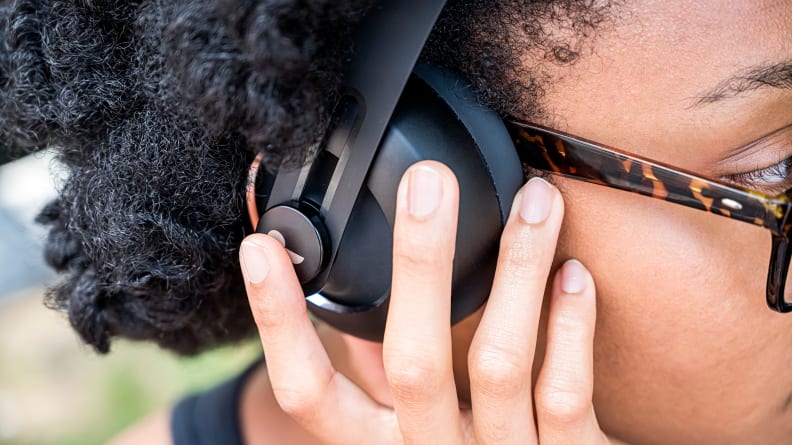
The Nuraphones feature touch-sensitive portions on each earcup that you can customize for control.
The touch controls on the Nuraphones are excellent: They're responsive, different enough that you'll rarely make the wrong gesture, and easy to remember. But we wish that they still had more conventional buttons for things like volume and skipping tracks somewhere, which would free up the gestures to do other things. Still, you can find nearly complete customization that you can tweak in the accompanying app.
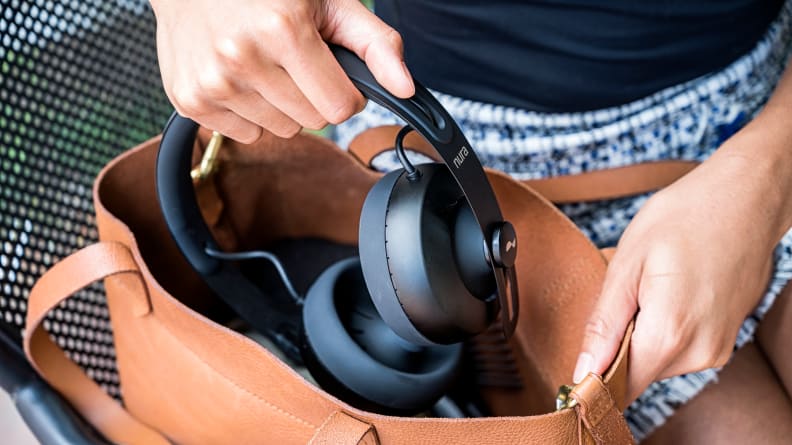
The Nuraphones aren't very portable, though they're moreso without the cumbersome carrying case.
As are most over-ear headphones, the Nuraphones take up a lot of real estate in a bag when you want to take them with you on the go—and even more if you stash them in the included carrying case.
Are Nuraphones worth it?
The main drawback of the Nuraphones: You can easily get the flagship noise-cancelling headphones from Bose, Sony, and others for the same or less money than Nuraphone’s ~$400 price. Am I willing to take a chance on an unproven company with a killer idea? Sure thing, if it's not something I'm going to have to rely on day-in and day-out.
But for many people, a nice pair of over-ear headphones is a once-ever-few-years purchase that they'll use all the time. It's just hard to expect people to decide to take a chance on the Nuraphones when other options (particularly the Sony WH-1000XM3, which cost about $50 less) are just so, so good.
Should you buy the Nuraphones?
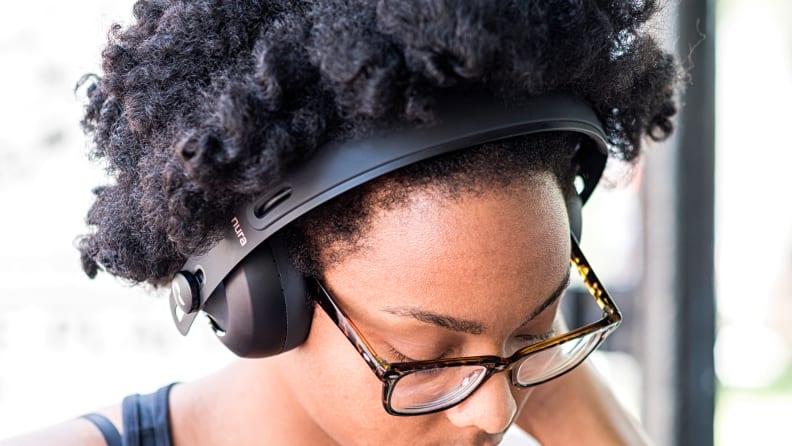
The Nuraphones look great and would be comfy if not for the in-ear earbud portion.
There are two ways of approaching the Nuraphones. On the one hand, it's an exciting technology that truly makes a difference and is surprisingly easy to set up. The ability to custom tune your headphones is an audiophile's dream, potentially giving you a pair of headphones that can improve over time and optimize itself for your hearing—maybe even someday on a track-by-track basis.
On the other hand, the Nuraphones' tuning can only do so much. The noise cancelling is good, but doesn't quite match the experience of using the best from Sony and Bose. The sound quality is excellent, but the design still means you're wearing a relatively heavy pair of headphones that jut in-ear monitors into your ears. That's just not as comfortable to me, though you do get used to it over time.
For early adopters looking to get in on a unique piece of technology, the Nuraphones are a treat. The design is cool, tinkering with the sound doesn't seem to ever get old, and for an early-gen product they absolutely nailed the basics like connectivity, battery life, and fit and finish. In a sea of great headphones they're a fun alternative with some unique hooks. Though I think most people will be happier with conventional choices like the Bose QuietComfort Series II or Sony WH-1000XM3 over-ears, if those aren't quite doing it for you these are worth checking out. You might just find what you've been searching for.
About the Nuraphones
Specs Wireless: Yes Colour: Black Transducer principle: Closed-back ANC, active noise cancellation: Yes Nominal Bluetooth range: 10 m Bluetooth codec: Qualcomm® aptX-HD* Frequency range: 20 Hz—20kHz Full scale input signal level: 0.5 VRMS Driver size: inner ear: 15mm, outer ear: 40 mm Driver type: Dynamic THD, total harmonic distortion: <1% SNR, signal-to-noise ratio: >125 dB
